Selecting the right soldering equipment is essential for ensuring precision, efficiency, and durability in electronics manufacturing and repair. Two commonly used tools in this field are the hot air soldering station and the soldering iron. While both serve the core purpose of joining or removing components on a printed circuit board (PCB), they differ significantly in terms of functionality, application, and operating methods.
This article provides a detailed comparison to help professionals and beginners choose the most appropriate tool for their specific needs.
What Is a Hot Air Soldering Station?
A hot air soldering station utilizes a stream of heated air to melt solder and manipulate components without direct contact. It is especially effective for surface-mount device (SMD) components such as BGAs, QFNs, and microchips. The operator can adjust both temperature and airflow to suit various tasks, making it ideal for delicate rework and component removal.
Advantages of Hot Air Soldering Stations:
- Precise temperature and airflow control
- Suitable for SMD and BGA components
- Non-contact heating reduces the risk of PCB damage
- Effective for rework, desoldering, and chip replacement
Hot air stations are typically used in professional environments where high precision is required, such as electronics repair centers, production lines, and R&D labs.
What Is a Soldering Iron?
A soldering iron is a traditional tool consisting of a heated metal tip used to melt solder for joining components. It is widely used for through-hole soldering, wire joining, and basic electronic assembly. The tool is generally lightweight, easy to operate, and suitable for both beginners and experienced users.
Advantages of Soldering Irons:
- Simple and user-friendly
- Ideal for through-hole and wire soldering
- Highly portable
- Cost-effective solution for basic repair tasks
Soldering irons are the preferred choice for educational settings, hobbyists, and general-purpose electronics work.
Comparison Overview
| Feature | Hot Air Soldering Station | Soldering Iron |
|---|---|---|
| Heat Source | Hot air stream | Heated metal tip |
| Application | SMD rework, chip removal, precision repair | Through-hole, cable soldering, basic assembly |
| Precision | High, with adjustable airflow | Moderate, manual control |
| Contact with Component | Non-contact | Direct contact |
| Learning Curve | Moderate | Easy |
| Cost | Higher | Lower |
| Portability | Less portable | Highly portable |
Which Tool Should You Choose?
The choice between a hot air soldering station and a soldering iron depends on the nature of your work.
You may consider a hot air soldering station if:
- You work with SMD, BGA, or densely packed PCBs
- You frequently perform component rework or desoldering
- You require precise, controlled heating without physical contact
On the other hand, a soldering iron is more suitable if:
- You focus on through-hole components or basic electronics
- You are new to soldering or working on simple projects
- You need a portable, cost-effective solution
For operations that involve both types of soldering tasks, a 2-in-1 soldering station that integrates both functions may be the most efficient choice.
Why Choose Gordak?
Gordak Electronics is a professional manufacturer specializing in high-quality soldering and rework equipment. Our range includes hot air soldering stations, precision soldering irons, and integrated 2-in-1 solutions, designed to meet the needs of both industrial users and electronics repair technicians.
- Trusted by professionals in over 60 countries
- Factory-direct quality and competitive pricing
- OEM and ODM services available
- Reliable after-sales support
For more information or to request a quotation, please contact us at info@gordakelec.com.
Conclusion
Both the hot air soldering station and the soldering iron play important roles in electronics assembly and repair. Understanding their differences allows you to choose the right tool for your application, whether you’re performing precise SMD work or general soldering tasks. As a trusted soldering tool manufacturer, Gordak is here to provide expert guidance and dependable solutions tailored to your requirements.
Contact us today to learn more about our full product range and OEM service options.
Email: info@gordakelec.com
Two-in-One & Hot Air Stations
Beginner’s Guide to Two-in-One Hot Air Rework and Soldering Stations
Two-in-One Rework Stations for Hobbyists vs. Professionals: What’s the Difference?
What to Look for When Buying a Two-in-One Soldering Station
Hot Air Soldering Station vs. Soldering Iron – Which One Should You Choose?
Hot Air Rework Station vs Desoldering Station
Hot Air Rework Station Vs Heat Gun
How to Use a Hot Air Rework Station
How To Use Hot Air Soldering Rework Station
Things To Consider Before Purchasing The Best Hot Air Rework Station



